Telescope & Astronomy Glossary

Stellarvue hopes this glossary will help during your astronomy journey. We don’t expect or assume this resource to be an end-all, be-all to explaining telescopes and astronomy. Our hope is that you’ll benefit from it, and use it to further your knowledge as your interest in telescopes and astronomy grows.
Aberration, Chromatic
An aberration of a lens in which light of different colors is not brought to the same focus point. This causes false colors and fringing in the image. See also ACHROMAT.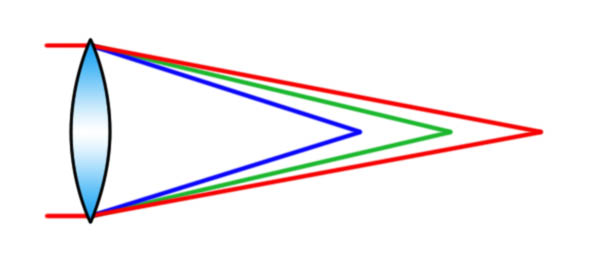
Aberration, Spherical
An aberration of a spherical lens or mirror whereby light rays falling near the edge of the optical element converge inside of focus while those near the center converge outside of focus, resulting in a sharp center and softer edges.
Absolute Magnitude
A measure of a star's true or intrinsic brightness. Essentially, astronomers decide this by gauging how bright the star would appear to the eye if brought to a standard distance of 10 parsecs, or 32.6 light-years. Alnitak, the easternmost star in Orion's belt, has an apparent magnitude of 2.05 but an absolute magnitude of -5.9, because that's how bright it would appear if it lay 10 parsecs away. The Sun, with an apparent magnitude of -26.7, has an absolute magnitude of 4.8. See also MAGNITUDE.
Achromat
A refractor objective lens comprised of two elements of different types of glass, which serves to greatly reduce chromatic aberration. Can also be called an achromatic objective lens.
Alt-azimuth Mount
A mount that allows a telescope to move freely in altitude (up and down) and azimuth (side to side, along the horizon). A standard photo tripod is an example of an alt-azimuth mount.
Altitude and Azimuth
Coordinate terms used in the horizontal coordinate system. Altitude is the angular distance of a celestial object above (numbered positive) or below (numbered negative) the horizon. Azimuth is the angular distance of an object measured eastward along the horizon from cardinal north (or 0°).
Aperture
The diameter of a refractor's light-gathering objective lens or a reflector's primary mirror.
Apochromatic
A refractor lens that virtually eliminates chromatic aberration; literally means "without color". This is often done by using exotic glasses or by using numerous lens elements for the objective lens. 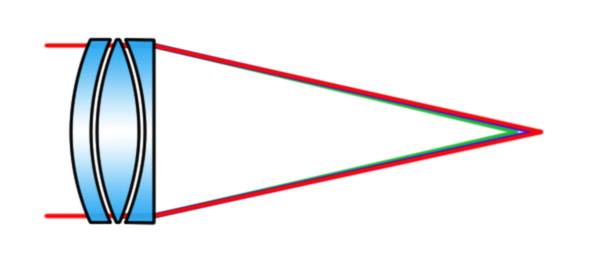
Apparent Magnitude
Refers to how bright the star appears to the naked eye. The difference between the apparent brightness of two stars follows a logarithmic ratio of 2.512. Hence, a star that is three magnitudes less than another is (2.512) 3, or about 16 times brighter. Using this system, stars can also have negative magnitude values, and these are the brightest we see in the sky. See also MAGNITUDE.
Arc Minute
A unit of angular measurement. One arc minute is 1/60th of a degree. Just as there are 60 minutes in one hour of time, there are 60 arc minutes in a one-degree angle.
Arc Second
A unit of angular measure consisting of 1/60th of an arc minute. A dime seen from a distance of 2 miles transects 1 arc second. There are 3,600 arc seconds in a one-degree angle. It is used to measure the separations of double stars or small deep-sky objects, like planetary nebulas. The full moon is about 30 arc minutes in diameter. See also DEGREE.
Astigmatism
One of the aberrations of a lens or mirror that may be seen in mass produced telescopes. The wavefront is shaped like a potato chip so light coming from different places around the lens does not come to focus at the same plane. This will distort the appearance of stars.
Autoguider
An electronic accessory used to take long exposure photography. The autoguider locks onto the image of a star and controls the tracking of the telescope to a far finer degree than a telescope drive system can do by itself.
Baffles
A series of rings placed along the light path within a refractor's tube with apertures that gradually "step down". Baffles prevent internal light scatter and hence increase contrast.
BAK-4 Glass
Also known as "barium crown" glass. BAK-4 is a superior-quality glass used to make optical prisms. It yields bright images and high contrast.
Balance System
A system of weights most often used with equatorial mounts to counterbalance the optical tube assembly of a telescope.
Barlow Lens
An achromatic lens that increases the effective focal length of the objective lens or primary mirror and doubles or triples eyepiece magnification. Hence, a 30mm eyepiece becomes a 15mm eyepiece when used with a 2x Barlow. Given a telescope with a focal length of 1200mm, a 30mm eyepiece yields 40x alone and 80x with a Barlow lens.
Binning
A procedure used to enhance the sensitivity of astronomical cameras. Binning 1x1 simply means each pixel on the CCD imaging chip counts as one pixel. Binning 2x2 or more is a method of increasing the sensitivity of the CCD imaging chip at the expense of resolution; adjacent pixels are summed together into super-pixels. For example, binning 2x2 would cause 4 pixels to act as one larger pixel (at a quarter of the resolution but about four times more sensitive).
BK-7 Glass
Also known as "borosilicate" glass. Most optical prisms are made of BK-7 glass.
Blower Bulb
A pliable hand-held bulb that, when squeezed, produces brief gusts of air. Used to blow dust off of optical surfaces.
Camera Adapter
An adapter - either a T-ring, T-adapter, or tele-extender - used to attach a 35mm SLR camera to a telescope for astrophotography.
Cassegrain
The optical configuration of a reflecting telescope in which a convex hyperboloid secondary mirror mounted inside the primary mirror's focal plane reflects light back down the tube through a hole in the primary mirror to a focal point just behind it. This in effect "folds" the focal length of the light path.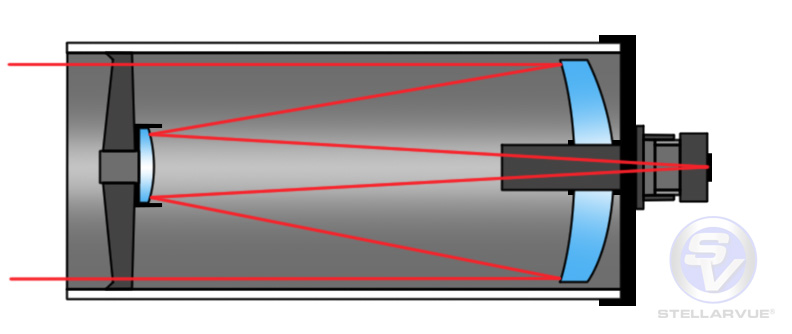
Catadioptric
A compound telescope that uses the benefits of both refraction and reflection to form an image. A typical catadioptric consists of a primary spherical mirror, a secondary mirror, and a correcting plate or lens to counter the aberration introduced by the spherical primary. It can be either Cassegrain or Newtonian in configuration.
CCD Camera
Short for "charge-coupled device". A CCD is a light-sensitive electronic detector widely used in making astronomical images. Sensitive over a wide range of wavelengths, and much more efficient than emulsion in gathering light, CCDs are often used to image extremely faint objects.
CCD Imaging Chip
The solid state electronic detector used in a CCD camera.
Center-Mark
A small dot centered on the primary mirror of a Newtonian reflector that greatly aids in collimating the optics. The dot does not interfere with the performance of the mirror because it lies within the obstruction of the secondary mirror.
CMOS
An acronym for Complementary Metal-Oxide Semiconductor. This is a type of imaging chip (which is an integrated circuit) named after the technology used to create this type of integrated circuit that has high noise immunity and low power consumption. This type of sensor is used in planetary and other lower-cost astronomical cameras.
Coated
Denotes that a coating of various materials are applied to lens surfaces to increase light transmission and improve contrast.
Coated, Fully
All air-to-glass surfaces are coated with a single coating layer to increase light transmission and improve contrast. A definite step up in quality from "coated".
Coated, Fully Multi
All air-to-glass surfaces receive multiple anti-reflection coatings.
Coated, Multi
All air-to-glass surfaces are coated with at least one layer of magnesium fluoride, with some surfaces receiving multiple anti-reflection coatings. A step up from "fully coated", but not quite as good as "fully multi-coated".
Coating, Anti-Reflection
A coating of magnesium fluoride or other materials to reduce reflections of light bouncing between one element and another within the optical path.
Coating, Phase
Special coatings applied to roof prism binoculars that enhance the contrast for the roof prism optical design.
Collimation
A process of adjusting the optical components of a telescope so they are aligned with each other.
Coma
One of the aberrations of a lens or mirror that may be seen in mass produced telescopes. This may be due to an imperfection in the lens or other components that results in stars appearing distorted. It is also seen in adequately figured telescopes when photographic field flatteners are not properly spaced from the camera sensor.
Counterweight
A weight that is placed on an equatorial, dobsonian, or other mount, to counterbalance the weight of the telescope tube assembly.
Crosshairs
Also known as reticle, it is a system of cross wires, dots, or rings in the focus of a finder scope or eyepiece for centering purposes.
Crown Glass
Glass used to make one of the two elements of an achromatic objective lens, or doublet. The other element is a plano-concave lens composed of flint glass. The two elements work together to focus light of different colors due to the dispersion of light through glass.
Dark Adaptation
The process of the eyes' pupils gradually dilating to their widest opening. Under dark skies, the average dilation aperture of the pupil is about 7mm, though this usually decreases slightly with age. On average, the process takes between 20 and 30 minutes. Red goggles can be worn prior to observing to achieve dark adaptation.
Dark Signal
Every CCD produces a certain amount of "false signal" which accumulates in the pixels during imaging. This electronic noise is produced by heat and can be reduced with a thermoelectric cooler.
Declination/Dec
One of the two celestial coordinates (the other being right ascension), declination is based off the celestial equator, an imaginary line from the Earth's equator extended into space. Values are given in degrees from -90 to +90. The negative values are located in the Southern Celestial Hemisphere; the positive values are in the Northern Celestial Hemisphere.
Degree
An angular unit of measurement equal to 1/360th of a circle. Hence, a great circle drawn across the sky from due east to due west would contain 180 degrees. From overhead to any point on the horizon is 90°. One degree is roughly equivalent to the diameter of two full moons side-by-side in the sky. Each degree is divided into 60 arc minutes and each minute further subdivided into 60 arc seconds.
Dew Shield
A covering of metal, carbon fiber, or abs wrapped snuggly around the tube assembly and extending beyond the aperture of a telescope to prevent dew from forming on the objective lens of a refractor or correcting plate of a Schmidt-Cassegrain or Maksutov telescope.
Diagonal, Correct-Image
A 45° or 90° diagonal used primarily for terrestrial viewing with refractors and Cassegrains because it renders images as the unaided eye sees them: upright and left-to-right. Some resolution is lost when using a correct-image diagonal, so it is generally not recommended for astronomical viewing.
Diagonal, Mirror
An accessory that fits into a telescope's focuser and diverts incoming light at a right angle. This is for viewing at a more comfortable angle when using a refractor or catadioptric telescope. Mirrors are used to redirect the light within the diagonal.
Diagonal, Prism
An accessory that fits into a telescope's focuser and diverts incoming light at a right angle. This is for viewing at a more comfortable angle when using a refractor or catadioptric telescope. Prisms are used to redirect the light within the diagonal.
Diffraction Limited
The point at which optical quality is good enough that the limits of viewing detail are determined by the physical properties of light, and not any optical defects in the telescope. See also RESOLUTION.
Dispersion
The breaking of white light into its component colors when it passes through one medium, like air, into another medium, such as glass. Dispersion is what causes chromatic aberration in lenses.
Dobsonian
An alt-azimuth telescope system developed by John Dobson in the 1970s. A Newtonian reflector telescope is mounted in a box-like cradle that allows the tube to move smoothly up or down (in altitude) and to pivot back and forth (in azimuth). Classic Dobsonian telescopes are known for their stability, ease of use, and quick set-up.
Double Star/Binary Star
A star that looks singular to the naked eye but, upon closer scrutiny with a telescope, appears to have two or more members. There are two types of double stars: optical doubles are mere chance alignments of stars with different distances, while physical doubles are gravitationally bound to each other. Such a system is often called a binary star.
Doublet
An objective lens made of two elements of glass of different refractive qualities (or indices) to counteract the effects of chromatic aberration. Also known as an achromatic lens.
Dovetail Bracket
A holder for finder scopes designed to interlock with a dovetail base on the optical tube and secured with a single thumbscrew. Larger versions can make it difficult to attach entire telescope tubes to their mounts, and come in two size standards: Vixen and Losmandy.
ED Glass
Short for "extra-low dispersion"; an optical glass that has superior refractive properties compared to standard optical glass. Lenses made with ED glass typically exhibit less chromatic aberration than lenses made with standard glass. It is the type of glass Stellarvue uses in their lenses.
Emission Nebula
An interstellar cloud of gas and dust in which hot embedded stars ionize much of the cloud's gas atoms, causing the nebula to emit its own light. The name is derived from the pattern of emission lines in the spectra of these nebulas. Examples include the Orion (see below) and Lagoon nebulas.
Emission-Type Objects
Galactic deep sky objects consisting of interstellar dust that is lit by the presence of hot nearby stars. The dust absorbs and then re-emits the photons, causing the dust to give off a glow. See also EMISSION NEBULA.
Enhanced Reflectivity Coatings
Aluminum deposited on a first surface telescope mirror that makes it reflective. Normal aluminum coatings reflect ~90% of the light; by overcoating the aluminum with ultra-thin coatings (called dielectric coatings), the reflectivity can be increased several percent.
Equatorial Mount
A telescope mount designed to facilitate easy tracking of celestial objects as they move across the night sky. One axis (the polar axis) is aligned to the celestial pole (parallel with Earth's axis), and the other (the declination axis) is oriented at right angles to it. Also called German equatorial mount.
Erecting Prism
A prism that produces an image oriented the same as seen with the naked eye.
Exit Pupil
The diameter of the light cone as it exits the telescope eyepiece. It appears as a distinct disk when the telescope is pointed at a bright source like the Moon. Also known as the Ramsden disk. The exit pupil varies with both aperture and magnification.
Eye Relief
The distance, measured in millimeters, between the observer's eye and the eyepiece lens in which the entire field of view remains visible. Eye relief varies with the optical design but generally increases with decreasing magnification. Long eye relief is advantageous for observers who wear glasses, as they don't have to put their eye directly on the eyepiece to see the entire field of view, nor do they have to remove their eyewear.
Eyeguard
A pliable rubber cup for eyepieces and binoculars that improves viewing comfort and helps block extraneous peripheral light.
Eyepiece
The part of the telescope that actually magnifies the image. Using different focal length eyepieces will change the resulting magnification of the telescope. Magnification is determined by dividing the focal length of the telescope (or binocular) by that of the eyepiece. Hence a telescope with a 1200mm focal length and an eyepiece of 40mm yields a magnification of 30x. The human eye is considered 1x magnification. Typically, an observer will own several eyepieces in order to accommodate a variety of different viewing situations. Eyepieces usually consist of three or more lens elements. A wide variety of designs, each with their own characteristics, are available.
Eyepiece Element
A glass lens in an eyepiece. Various eyepiece designs employ various elements to increase contrast, flatten viewing fields, or provide sharp views at high magnifications.
Eyepiece, 2"
An eyepiece with a 2" barrel rather than the standard 1-1/4". Two-inch eyepieces can provide exceedingly wide fields of view and are favored by deep-sky observers.
Eyepiece, Illuminated
An eyepiece with a red-illuminated crosshair, or reticle, that can be adjusted for brightness. Illuminated eyepieces are used in astrophotography to keep a faint guide star exactly positioned relative to the crosshairs, or in eyepieces with an illuminated micrometric scale for making small angular measurements.
Eyepiece, Kellner
A basic three-element eyepiece that produces acceptably bright images, though with somewhat narrow fields of view. Kellners work best on long-focal-length telescopes and exhibit slight chromatic aberration.
Eyepiece, Lanthanum
An eyepiece design in which one of the eyepiece elements is made of lanthanum, a rare-earth element that eliminates visual aberrations.
Eyepiece, Orthoscopic
A four-element ocular with less chromatic aberration than a Kellner but a narrow field of view. Still highly regarded by many amateur astronomers as one of the best for lunar and planetary viewing.
Eyepiece, Plössl
A four-element eyepiece consisting of two nearly identical pairs of lenses. Plössls provide sharp, high-contrast images and flat fields of view. One of the best all-purpose eyepiece designs.
Eyepiece, Zoom
Provides a continuous magnification range and hence the option of using a single eyepiece versus switching from one to another. The less expensive zooms sometimes suffer from internal reflections, unless they've been properly coated and their internal barrels blackened or glare-threaded.
Field of View, Apparent
The edge-to-edge angular diameter of the light emerging from the eyepiece as seen by the eye. It is an inherent specification for a given eyepiece type or design. The apparent field of view of an eyepiece is directly related to the true field of view seen through the telescope; for a given focal length eyepiece, the greater the eyepiece's apparent field of view, the greater area of sky will be seen.
Field of View, True
The actual field of view of the eyepiece when inserted into a telescope. The true field of an eyepiece may be determined by dividing the eyepiece's apparent field of view (provided by the manufacturer) by the magnification. For example, an eyepiece with an apparent field of view of 40° at a magnification of 30 yields a true field of view of 1.3°.
Field Stop
The field stop is the aperture that limits the field of view of a telescope eyepiece lens system. Most field stops consist of a metal ring inside an eyepiece barrel that limits the field of view of the eyepiece lens system. A telescope eyepiece field stop appears as a circle surrounding the visible field of view when you look through the eyepiece. The angular diameter of this circle is called the apparent field of view (AFOV) of the eyepiece and is a fixed property for each eyepiece design. Zoom eyepieces with an adjustable focal length range may employ an adjustable field stop, the aperture of which shrinks and expands in correlation with focal length setting adjustments.
Filter, Color
Glass filters, each of a specific color, which screw onto eyepiece barrels for enhancing lunar and planetary detail. Various color filters reduce other interfering or scattered wavelengths that blur certain wavelength-specific features. Red filters, for example, bring out Martian surface detail while green increases contrast of Jupiter's Red Spot. Also called planetary filters.
Filter, Light-Pollution
A filter that threads on to an eyepiece or rear cell of a Schmidt-Cassegrain that blocks wavelengths of light pollution sources such as mercury vapor and high-pressure sodium, but pass wavebands specific to deep-sky objects, such as hydrogen alpha, hydrogen beta, and oxygen III.
Filter, Moon
A glass filter in an aluminum cell that threads onto an eyepiece barrel and reduces the Moon's glare so that it can be comfortably observed. Without the eye being overwhelmed by moonlight, more lunar detail becomes apparent.
Filter, Planetary
Glass filters, each of a specific color, which screw onto eyepiece barrels for enhancing lunar and planetary detail. Various color filters reduce other interfering or scattered wavelengths that blur certain wavelength-specific features. Red filters, for example, bring out Martian surface detail while green increases contrast of Jupiter's Red Spot. Also called color filters.
Filter, Solar
A glass filter that fits snugly over the aperture of a telescope and allows the photospheric surface of the Sun — sunspots and solar faculae — to be observed comfortably and safely. A good solar filter blocks some 99.99% of the Sun. Observing the Sun without a solar filter may cause serious damage to the eye.
Filter, Variable-Polarizing
Variable-polarizing filters act as dimmer switches to bright celestial objects, including the Moon or a planet. The filter, which threads on to 1.25" eyepiece barrels, consists of two pieces of polarized glass mounted in an aluminum cell that, depending on how much it is rotated, varies light transmission from 1% to 40%.
Finder Scope
A low-power, wide-field telescope mounted on the main optical tube assembly used to locate celestial objects for viewing through the main telescope.
Finder Scope, Right-Angle
Same as a finder scope, but with a right-angle diagonal to divert incoming light 90° to the light path rather than sighting along the tube. Permits more comfortable viewing for observers using reflectors.
Flashlight, Red
A flashlight that emits only pure red light, so as not to impair the night vision of the observer. The human eye is insensitive to red light.
Flint Glass
One of the optical components of a doublet or achromatic objective lens of a refractor. Combined with crown glass, the elements work together to bring the colors inherent in white light into the same focus.
Focal Length, Eyepiece
The distance from the center of the field lens (where light passes through the first element of the eyepiece) to the focal point. The magnification of a telescope varies with the eyepiece focal length. Short focal-length eyepieces produce high magnifications; long focal-length eyepieces produce low magnifications.
Focal Length, Telescope
The distance from the center of a curved mirror or lens at which light rays converge to a single point. Light rays are assumed to come from an effectively infinite distant pinpoint light source (like a star) and so are parallel when they reach the mirror or lens. The focal length is an inherent specification of a mirror or lens and is one of the factors in determining resultant magnification for a telescope (along with the focal length of the eyepiece being used).
Focal Plane
The imaginary plane suspended in space where the image is created by a telescope. The eyepiece magnifies a section of the telescope's focal plane in order to produce the images seen. When prime-focus astrophotography or telephoto photography is attempted, the camera's film is positioned at the precise position of the telescope's (or camera lens') focal plane.
Focal Ratio (F-Ratio)
The ratio of a telescope's focal length to its aperture. Short focal ratios (f/5, f/4.5) produce wide fields of view and small image scales, while long focal lengths produce narrower fields of views and larger image scales.
Focal Reducer
Shortens the effective focal length of long focal-length telescopes by nearly half, thus providing wider fields of view for visual or photographic use.
Focuser
A device into which an eyepiece is inserted and adjusted to bring a telescopic image to focus. A focuser can be as simple as a manual drawtube, but the more efficient type is the "rack-and-pinion" design, whereby a threaded axle affixed with knurled knobs at each end meshes with a threaded drawtube, enabling it to be moved up or down through the focal plane.
Focuser, Dual Speed
A mechanical focuser design with both course and fine adjustment speeds.
Focuser, Crayford
A mechanical focuser design developed in Crayford, England that uses precision bearings and finely machined surface tolerances to deliver far more precise and blacklash-free focuser movement.
Full Well Capacity
A measure of the amount of signal electrons collected by each individual pixel in a CCD imaging chip. The higher the full well capacity, the more light CCD pixels can collect without over-saturating the signal.
Galaxy
A vast system of several billion to hundreds of billions of stars. Galaxies come in multifarious shapes but are generally classed as spirals (pinwheel), ellipticals (spherical), and irregulars (amorphous). Examples include the Andromeda Galaxy (M31 shown below) and our own Milky Way galaxy.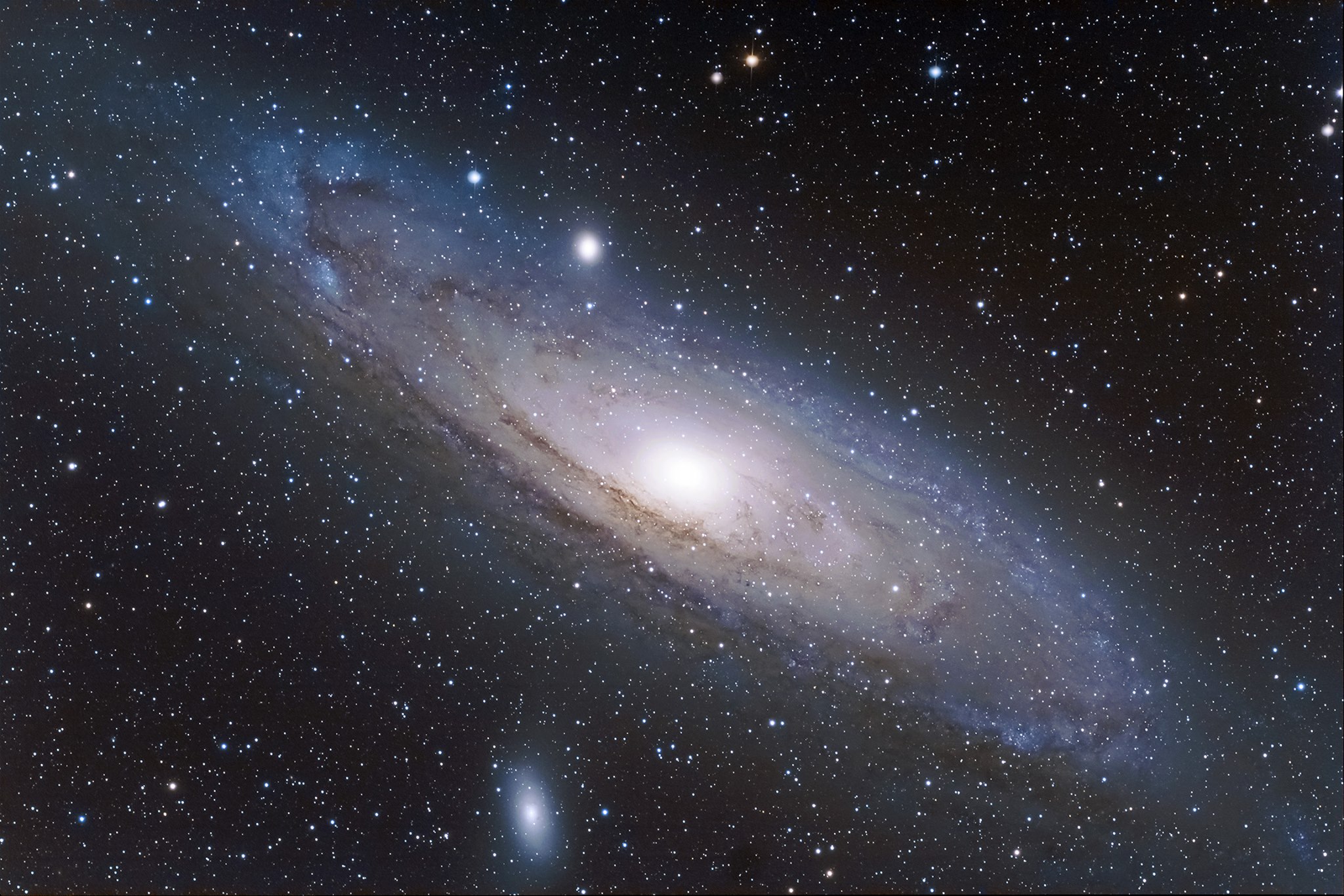
German Equatorial Mount
A telescope mount designed to facilitate easy tracking of celestial objects as they move across the night sky. One axis (the polar axis) is aligned to the celestial pole (parallel with Earth's axis), and the other (the declination axis) is oriented at right angles to it. Also called equatorial mount.
Globular Cluster
A compact spherical aggregate of several tens of thousands to millions of stars. Globulars are highly concentrated in the center, but thin out around the periphery. They are not galaxies themselves, but they are gravitationally bound to their "parent" galaxy. Many astrophysicists believe globular clusters are remnants of galaxy formation. Examples include the Great Hercules Cluster (M13) and Omega Centauri.
Guide Scope
A telescope affixed to another telescope on the same mount and used in astrophotography to ensure that the object being imaged remains fixed in the camera's field. The observer monitors a "guide star" through the guide scope and makes small adjustments in right ascension and declination to prevent drift that would otherwise blur the target and hence ruin the exposure. Alternatively, an auto-guider can be used with the guide scope instead of manually guiding the telescope.
Guide Star
See GUIDE SCOPE.
Illuminated Reticle Eyepiece
An eyepiece with a red-illuminated crosshair, or reticle, that can be adjusted for brightness. Illuminated eyepieces are used in astrophotography to keep a faint guide star exactly positioned relative to the crosshairs or in eyepieces with an illuminated micrometric scale for making small angular measurements.
IR Cut-Off Filter (IR Filter)
A filter used to block longer infrared wavelengths of light. CCD and CMOS sensors in astronomical cameras are sensitive to this type of light, so if it is not blocked, image sharpness or contrast may be affected.
LED
Short for "light-emitting diode", an LED emits light at low voltage levels. They are used in electronic displays and, as an emitter of pure red light, in astronomy flashlights.
Lens Element
Multiple pieces of glass spaced tightly together in a cell to work as a single unit (see OBJECTIVE LENS). A single glass lens in an eypiece. Various eyepiece designs employ various elements to increase contrast, flatten viewing fields, or provide sharp views at high magnifications.
Light Grasp
A measure of a telescope's ability to gather light. Light grasp is determined almost solely by the diameter of the aperture of a telescope's objective lens: the larger the aperture, the greater the light grasp and the greater the resolution or amount of detail that may be observed. Measured in square inches.
Light Pollution
Stray light generated by unshielded high-pressure sodium and mercury vapor, street and security lighting, billboard uplighting, glaring porch lights, and poorly-designed landscape illumination that radiates upward or into the eyes, lowering sky contrast and significantly degrading the visibility of the stars.
Magnesium Fluoride
A coating applied to the optical surfaces of refractors, binoculars, and eyepieces that greatly enhances light transmission.
Magnification
A measure of the enlargement of an object seen through an optical instrument. More specifically, it is a measure of the angle subtended by an image viewed with optical aid divided by the angle subtended by the same object without optical aid. Magnification is determined by dividing the focal length of the telescope (or binocular) by that of the eyepiece. Hence a telescope with a 1200mm focal length and an eyepiece of 40mm yields a magnification of 30x. The human eye is considered 1x magnification.
Magnitude
A measure of the brightness of a star or deep-sky object. The magnitude system is not exactly intuitive since the brighter the object, the lower the value assigned. A magnitude 1 star, for example, is brighter than one of magnitude 2.
Magnitude, Absolute
A measure of a star's true or intrinsic brightness. Essentially, astronomers decide this by gauging how bright the star would appear to the eye if brought to a standard distance of 10 parsecs, or 32.6 light-years. Alnitak, the easternmost star in Orion's belt, has an apparent magnitude of 2.05 but an absolute magnitude of -5.9, because that's how bright it would appear if it lay 10 parsecs away. The Sun, with an apparent magnitude of -26.7, has an absolute magnitude of 4.8.
Maksutov (MAK)
A catadioptric reflecting telescope similar to a Schmidt, except that it employs a deeply curved full-aperture lens called a meniscus to correct for spherical aberration. Maksutovs utilize spherical mirrors and can be designed with a Cassegrain configuration, in which case they are called Maksutov-Cassegrains, or as Newtonians, in which case they are called Makstutov-Newtonians (or MAK-Newts, for short).
Maksutov-Cassegrain
See MAKSUTOV (MAK).
Messier Objects
Bright "nebulas" (subsequently identified as star clusters, nebulas, and galaxies) cataloged in the late 18th century by French astronomer Charles Messier (pronounced MEZ-ee-ay). Messier ostensibly compiled his catalog in order to avoid confusing the cloud-like objects with comets, which were his specialty. Today, the list contains 110 objects, though the identities of some of the entries are still debated.
Mirror Cell
A frame which holds the primary mirror of a reflecting telescope. The frame must be designed to hold the mirror securely, but not tightly to avoid "pinching" the glass (and thus introducing image distortion), well-ventilated to allow the glass to cool down to ambient air temperature, and adjustable so the mirror can be properly collimated.
Multi-Coatings
All air-to-glass surfaces are coated with at least one layer of magnesium fluoride, with some surfaces receiving multiple anti-reflection coatings. A step up from "fully coated", but not quite as good as "fully multi-coated".
Nebula
A discrete cloud of dust and gas associated with either star formation (see EMISSION NEBULA), reflecting the light of adjacent stars (see REFLECTION NEBULA), or as a shell surrounding a dying star (see PLANETARY NEBULA). A nebula can also appear as a dark cloud seen silhouetted by stars behind it or as a "hole" in space. These are referred to as Dark Nebulas.
Newtonian Reflector
A telescope designed with a spherical or parabolic primary mirror at one end of the tube that reflects and focuses light back along the optical axis to a secondary mirror, which, in turn, redirects the light at a right angle to the optical axis and into an eyepiece. First designed by Isaac Newton around 1670.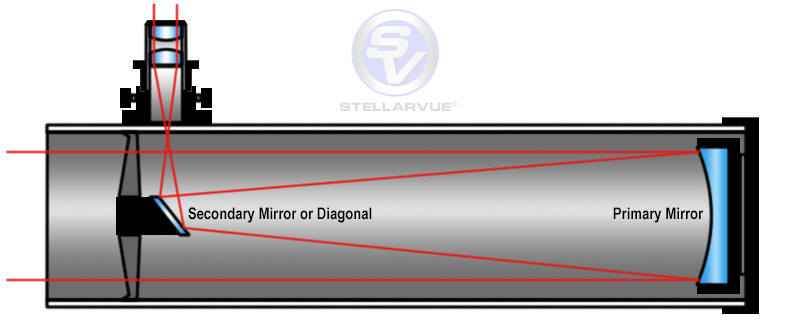
NGC Catalog
An acronym for New General Catalog of Nebulae and Clusters of Stars, first compiled in 1888 by Danish astronomer J.L.E. Dreyer at Armagh Observatory, Ireland. Today the catalog contains 7,840 deep-sky objects. A fair number are visible with small telescopes, but many require large-aperture instruments and dark skies.
Objective lens
The main light-gathering lens or lens system of a refracting telescope or binocular. Below is an objective lens element illustrating three individually shaped pieces of glass held in a cell.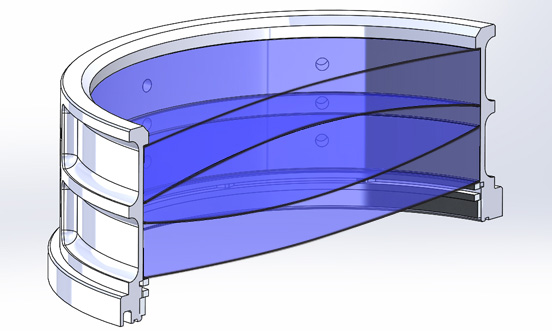
Ocular
An alternate term for an eyepiece.
Off-Axis-Guider
A device employing a lateral prism to capture a small outlying area of the telescope's field of view allowing an astrophotographer to view it through a guiding eyepiece during a long exposure (or use an autoguider).
Open Cluster
A loose array (though some can be remarkably compact) of tens to thousands of stars located near each other in space. Open clusters are weakly bound gravitationally and tend to gradually disperse over periods of millions of years. Examples include the Pleiades, Hyades, and the Double Cluster.
Open Star Cluster
See OPEN CLUSTER.
Optical Tube Assembly (OTA)
The main tube of a telescope including the objective lens or primary mirror, focuser, and finder scope. The optical tube assembly does not include a mount or tripod.
Parabolic Mirror
A mirror with a concave, polished, and aluminized surface designed to bring light to a focus at a certain prescribed distance or focal length.
Parfocal
Refers to eyepieces of varying focal lengths but designed so that little or no focusing is required when switching from one to another. Usually manufactured as a series.
Photography, Afocal
A technique in which a camera is coupled to a telescope's tube assembly via a bracket (or mounted separately on a tripod) and positioned where the eye would normally observe the image. The image formed by the eyepiece is then photographed through the camera lens.
Photography, Eyepiece Projection
An astrographic technique similar to afocal photography except that the camera lens is not used. Instead, the eyepiece image projects directly onto the film. Projection systems can use Barlow lenses or any type of eyepiece.
Photography, Piggyback
A method whereby a 35mm camera is "piggybacked" via a bracket or some other means to the tube assembly of a telescope on an equatorial mount equipped with an electronic drive. As the telescope tracks in right ascension, exposures of wide-angle regions of the sky can be made. If a telephoto is attached, magnified images of the Moon, comets, or deep-sky objects can be captured.
Photography, Prime Focus
An astrographic technique in which a 35mm camera is positioned at a telescope's prime focus: the focal plane of the primary mirror or objective lens. No eyepiece is used. Instead, the telescope and camera work together as a unit. This method provides the highest light transmission with lowest possible power, the widest field of view, and the best definition. Sometimes the image plane cannot be accessed because it falls within the focusing tube.
Pixel (or Picture Element)
In digital imaging, this is smallest single element in a digitally-produced image and corresponds to a physical element on the chip. The smaller the size of the pixel, the higher the image resolution the imaging chip can produce. Pixels are usually measured in microns.
Planetary Nebula
The shell of gas expelled by a dying star. Many appear circular or doughnut-shaped. Examples include the Ring and the Dumbbell nebulas.
Planisphere
A hand-held circular star map or "star wheel" that shows the positions of the constellations and prominent deep-sky objects in the sky from a given range of latitude at any desired date and time.
Polar Alignment
Aligning the right ascension axis of an equatorial mount to the celestial pole so that it is parallel with Earth's axis. Rough polar alignment is required for a clock drive or guiding system to track east-to-west without appreciable north-south (declination) drift. For astro-photography, polar alignment must be precise.
Polar Alignment Scope
A small finder scope built into the right ascension axis of an equatorial mount that greatly facilitates polar alignment. Also called a polar axis finder.
Polar Axis
The right ascension axis of an equatorial mount aligned such that it is parallel to Earth's rotational axis. See also RIGHT ASCENSION and SETTING CIRCLES.
Power
Power refers to a telescope's magnification (i.e., 40x can be referred to as 40 "power").
Primary Mirror
The main light-gathering mirror of any reflecting telescope opposite the skyward end.
Prism
A solid glass figure cut with flat surfaces. Optical prisms are used in binoculars and star diagonals and are made from either BK-7 (borosilicate) glass or BAK-4 (barium crown) glass.
Pyrex®
A high-quality glass known for its low thermal-expansion properties, meaning that it is less affected by changing temperatures, and hence preferred for making primary mirrors of reflecting telescopes.
Rack-and-Pinion Focuser
A device into which an eyepiece is inserted and adjusted to bring a telescopic image to focus. A focuser can be as simple as a manual drawtube, but the more efficient type is the "rack-and-pinion" design, whereby a threaded axle affixed with knurled knobs at each end meshes with a threaded drawtube, enabling it to move in and out through the focal plane.
RCA Cable (or RCA Connector)
Sometimes called a phono connector, this is a type of electrical connector used to carry audio or video signals.
Read Noise
Electronic noise present in all CCD chips.
Reflection Nebula
An interstellar dust cloud that reflects light from adjacent stars as opposed to having its constituent atoms ionized by embedded hot stars, which allows the nebula to shine by its own light (see EMISSION NEBULA). In long-exposure images, reflection nebulas are blue in color. Examples include the blue half of the Trifid nebula and the nebulosity surrounding the Pleiades star cluster.
Reflector
A telescope that uses a mirror to collect and focus light. Reflectors come in a variety of designs, including Newtonians and Schmidt-Cassegrains.

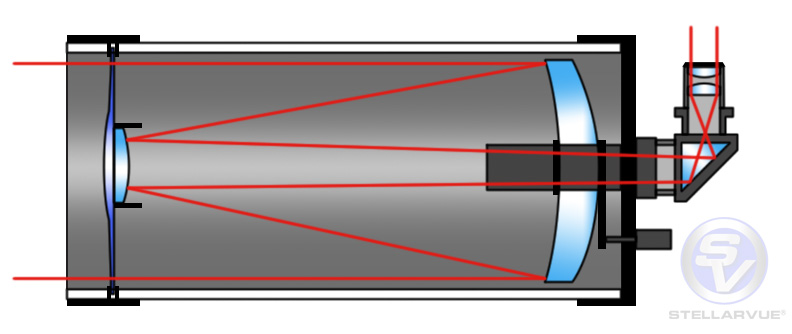
Reflex Sight
A lens-less finder that superimposes a pinpoint red LED-powered dot focused at infinity on the sky. When aligned with the main optical tube of the telescope, the dot indicates where the main field of the telescope is aimed (similar to a red dot finder on a rifle).
Refractive Index
The ratio of the velocity of light in a vacuum to the velocity of light through a material medium. Glass with different refractive indices bends light at different angles, which affects optical design. Different types of glass have difference indices of refraction.
Resolution
The resolving power of a telescope can be calculated with the following formula: resolving power (in arc seconds) = 4.56 ÷ aperture of telescope (in inches). In metric units, this is: resolving power (in arc seconds) = 116 ÷ aperture of telescope (in millimeters). Note that the formula is independent of telescope type or model, and is based only upon the aperture of the telescope. So the larger the telescope's aperture, the more it is capable of resolving. This is important to keep in mind when observing astronomical objects which require high resolution for best viewing, such as planets and double stars.
Reticle
A system of cross wires, dots, or rings in the focus of a finder scope or eyepiece for centering purposes. Also known as crosshairs.
RGB Color
A digital color image of an astronomical object constructed from the superposition of three separate Red, Green, and Blue images. This type of imaging can give very high-contrast, dramatic results, even in light-polluted skies. Special filters and a "monochrome" camera are required for best results.
Right Ascension (RA)
A coordinate used in the equatorial coordinate system, somewhat analogous to longitude on Earth, but scaled in hours, minutes, and seconds eastward along the celestial equator. One hour of right ascension is equal to 15 degrees, which is the angle through which the celestial sphere rotates in an hour's time. See also POLAR AXIS and SETTING CIRCLES.
Ritchey-Chretien
A type of cassegrain reflector telescope design. Both primary and secondary mirrors are polished to a hyperbolic shape, which delivers a very flat image plane; used primarily by advanced astrophotographers.
Schmidt-Cassegrain
A catadioptric configuration consisting of a spherical primary mirror and a convex secondary mirror affixed to an aperture-wide correcting plate. The secondary mirror directs the focused light back down the tube through a hole in the center of the primary mirror and into an eyepiece or camera. The thin correcting plate is curved along its periphery so that it counteracts aberrations inherent in the spherical mirror. This adaptation produces a flat field and high-quality images in a compact telescope tube.
Secondary Mirror
A small flat or curved mirror that intercepts light coming from the primary mirror of a reflecting telescope and directs it into an eyepiece. In Newtonian reflectors, the secondary mirror is often referred to as the diagonal (diagram below shows secondary mirror centered in tube towards left side of illustration).
Seeing
The general term used by professional and amateur astronomers to describe the "stability" of the air above you and therefore the steadiness of an image viewed through a telescope. "Poor seeing" comes from turbulent air and "good seeing" is the result of viewing through stable, steady atmospheric conditions. Seeing will vary nightly and even moment to moment; it is generally better in early morning (after midnight) when the ground has had time to cool from the heat of the day, since heat rising off the ground is a major source of "poor seeing".
Setting Circles
Two graduated circular scales provided on the right ascension and declination axes of a telescope that aid in locating an object by its celestial coordinates. The declination scale runs from -90° to 90°. The RA scale goes from 0 hours to 24 hours, subdivided into minutes and, if the scale is fine enough, seconds. Setting circles are set up by first sighting on a star of known right ascension and declination and adjusting the RA and Dec. circles to those coordinates. Then the observer need only maneuver the telescope to the coordinates of the desired target, which should be in the field of view or very near it.
Setting Circles, Digital
Most GOTO or robotic telescope systems have digital electronic read-outs of the precise position of where a telescope is pointed in the sky (the correct astronomical coordinates in RA and Dec., if the telescope has been set up correctly). Such telescopes may or may not have mechanical setting circles as well.
Sidereal Rate
The rate at which an equatorial mount has to be driven around its right ascension or polar axis to track stars continuously across the sky. It is equivalent to one rotation per 23 hours, 56 minutes, and 4 seconds.
Slew
To move, manually or electronically, a telescope about its mount's axes of rotation at a relatively fast rate. Typically, a telescope is slewed to an object's general location, then fine adjustments are made to position the object within the telescope's field of view.
Slow-Motion Controls
Knobs, or cables affixed with knobs, attached to a telescope mount that allow the observer to manually move a telescope's tube incrementally. Slow-motion controls can be used to center an object within the field of view.
Spherical Mirror
The type of mirror used in catadioptric telescopes (Schmidt-Cassegrains [diagram below] and Maksutovs) whose curve forms part of a sphere. Spherical mirrors are easier to manufacture than parabolic mirrors; however, they produce positive spherical aberration. To address this issue, a large corrector plate is placed in the front as shown in the diagram below. 
Spiral Galaxy
A disk galaxy with a whirlpool or pinwheel shape. The pattern may appear tightly wound or extremely loose. Seen "edge-on", a spiral galaxy looks saucer-shaped and exhibits a central bulge and dust lane.
Spotting Scope
A small, portable telescope used primarily for terrestrial observing, such as nature study and bird watching. Most spotting scopes use prisms to provide an image that matches the naked eye.
Star Cluster
See OPEN CLUSTER and GLOBULAR CLUSTER.
Star Diagonal
An eyepiece adapter containing either a flat mirror or prism that directs the light at a right angle to the optical axis. Used primarily for refractors, Cassegrains, or Schmidt-Cassegrains so that the observer doesn't have to look "straight through" the telescope tube at an uncomfortable angle.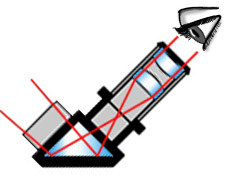
Star Hopping
A deep-sky observing technique whereby the telescope is moved in successive steps from star to star closer toward the field of view of the object of interest.
T-Adapter
A camera adapter that attaches to the body of a 35mm camera (without the lens) and then connects to the focuser for prime-focus astrophotography.
T-Ring
Converts the lens mount on a camera body to a standard "T-thread" that can accept a T-adapter or universal camera adapter for either prime focus or eyepiece projection photography.
Teflon®
A frictionless synthetic material used as a bearing surface.
TeleCompressor
See FOCAL REDUCER.
Telescope
As defined by Webster: a usually tubular optical instrument for viewing distant objects by means of the refraction of light rays through a lens or the reflection of light rays by a concave mirror. Below illustrate two basic designs: a refractor (below left) and a reflector (below right). The diagrams show how light is directed once entering the skyward end (shown in red) of the telescopes to the eyepiece. (Stellarvue manufactures refractor telescopes.)
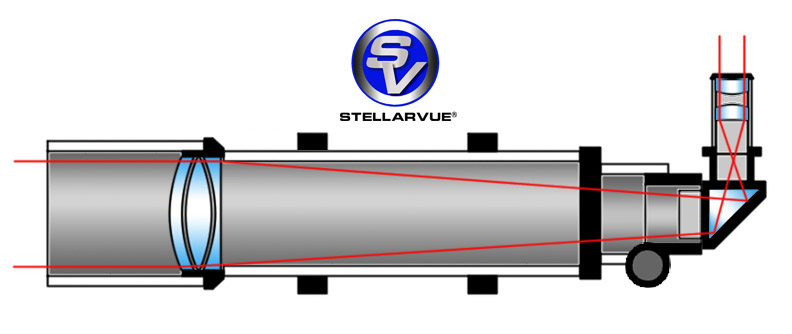

Telescope, "Fast"
A short focal-length (f/4 to f/6) telescope that renders bright prime-focus images on film, permitting shorter, or faster, exposures. Fast telescopes also provide a wider field of view compared to longer scopes.
Telescope, "Rich-Field"
A short focal-length telescope designed for sweeping very large regions of sky such as star fields (hence the name "rich"). Also known as wide-field telescopes.
Telescope, "Slow"
A long-focal-length telescope (f/8 or greater) that takes more time to produce a bright image on film at prime focus. Visually, images in both fast and slow telescopes, when viewed at the same magnification, have exactly the same apparent brightness.
Terrestrial
Refers to bird watching and landscape or seascape daytime observing with a telescope, binoculars, or spotting scope.
Tracking
Using a motor drive to remain continuously fixed on a celestial object as the earth rotates.
Transparency (also Atmospheric Transparency)
The term astronomers use to rate how "clear" the night sky is; a very transparent night is very clear with no clouds or haze and objects seen through the telescope are bright and full of contrast. Transparency can vary from night to night, and even hourly during a single night.
Tripod, Camera
A three-legged stand with a swivel or pan head upon which a camera, spotting scope, or binoculars can be attached.
USB (or USB Connector or USB Port)
Acronym for Universal Serial Bus is a standard for cables and connector ports used to establish communications between devices and a host controller (usually a PC).
Variable Star
A star that fluctuates in apparent brightness over a period of time. Examples include Delta Cephei, Betelgeuse, and Algol.
Wave Surface Accuracy
The standard tolerance for high-precision optics is one-quarter of the wavelength of yellow-green light, which is 22 millionths of an inch. In numeric terms, 1/4-wave means that the surface of a parabolic mirror must not depart more than about 6 millionths of an inch from a perfect theoretical shape.
Worm Gear
A toothed wheel that meshes with the thread of a "worm" or screw that, when rotated, uniformly moves an axis of a telescope mount.
Zenith
The point in the sky directly over the observer's head.
